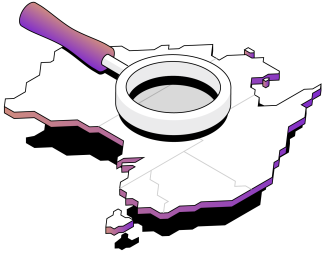

About Australian energy markets
Learn about the different players and regulatory bodies who administer Australia's energy markets, so you can understand who you may need to contact, and why.
Overview of Australian energy markets
There are a large number and variety of roles in Australian energy markets. Laws, rules and regulations apply to people engaging in energy at all stages of the market, so it's important to understand the role and context of your project within the broader market, and what rules might apply.
While similar roles and responsibilities apply to gas and electricity providers, these are governed in part by their own frameworks.
Generally, there are the following kinds of roles in traditional Australian energy markets:
- Generators – those who generate electricity and those who produce gas from primary sources which then flows into the transmission network
In relation to electricity, a transmission networks is the extra high voltage poles and wires that take power from large scale electricity generators to distribution networks..
- Network operators – those who operate the transmission network which transports electricity and gas from Generators to the distribution network
In relation to electricity, distribution networks are the low voltage poles and wires that take power from the transmission networks to homes and businesses across Australia..
- Distributors – those who operate the distribution network which transports electricity and gas to residential and commercial buildings.
- Retailers (sellers) – the companies which sell electricity and gas to residential and commercial users, acting as middle-parties between users and Generators.
- Energy consumers – everyone from individuals to businesses to community groups who buy energy.
- Regulators and rule-makers – Government and Industry bodies who manage and regulate the market. For example, the Australian Energy Regulator
The Australian Energy Regulator (AER) regulates electricity networks and covered gas pipelines in all jurisdictions except Western Australia. The AER sets the amount of revenue that network businesses can recover from customers for using these networks. The AER also enforces the laws for the National Electricity Market (NEM) and spot gas markets in southern and eastern Australia, as well as monitoring and reporting on the conduct of market participants and the effectiveness of competition.(AER) or the Australian Energy Market OperatorThe Australian Energy Market Operator (AEMO) manages electricity and gas systems and markets across Australia, helping to ensure Australians have access to affordable, secure and reliable energy. Ownership of AEMO was – and still is – shared between government and industry, with members representing federal and state governments, as well as generation and production, distribution, retail and resources businesses across Australia. AEMO has always operated on a user-pays cost-recovery basis, and it recovers all operating costs through fees paid by industry participants.(AEMO).
However, as new technologies emerge, modern Australian energy markets are becoming more dynamic, and the lines between generators, retailers and customers are less clearly defined. For example, an energy consumer with rooftop solar can both consume and also generate and export electricity to the wholesale market, and as such has a two-way relationship with the network.
As technology changes, the rules that govern these markets need to adapt to facilitate new scenarios and enable innovation. The Energy Innovation Toolkit is part of that solution.
The National Electricity Market (NEM)
The National Electricity Market
The NEM is also a marketplace through which generators and retailers trade electricity in Australia. It interconnects five states that also act as price regions: Queensland, New South Wales (including the Australian Capital Territory), South Australia, Victoria, and Tasmania. The NEM delivers around 80% of all electricity consumption in Australia.
Western Australia and the Northern Territory are not connected to the NEM. They have their own electricity systems and separate regulatory arrangements.
- For more information about Western Australia's Wholesale Electricity Market
Wholesale electricity markets are markets in which generators sell electricity and retailers buys electricity. Retailers buy electricity to on sell to end users.(WEM), please see the Government of Western Australia's WEM information page.- For more information about electricity markets and power systems in the Norther Territory, please see the website of the Northern Territory Electricity System and Market Operator (NTESMO).
Gas markets
Most wholesale gas in Australia is sold and transported under bilateral agreements between producers, pipeline owners, retailers and major users. AEMO operates a number of wholesale markets, including the Declared Wholesale Gas Market
Market bodies and state entities
Several government agencies are responsible for energy in the NEM and gas markets. The three market bodies are:
- The Australian Energy Regulator (AER)
- The Australian Energy Market Commission
The Australian Energy Market Commission (AEMC) is an independent statutory body that works for Australia's future productivity and living standards by contributing to a decarbonising, affordable and reliable energy system for consumers. The AEMC makes and amends the National Electricity Rules (NER), the National Gas Rules (NGR), and the National Energy Retail Rules (NERR), and manages the rule change process. The AEMC does this in accordance with the national energy objectives, the central focus of which is the long-term interests of consumers. They also provide market development advice to governments.(AEMC), and
- The Australian Energy Market Operator (AEMO).
These organisations oversee the nation’s energy market and report to the Federal and State Government Energy Ministers. Each has a different role. The AEMC consults with stakeholders and drafts the rules which govern the NEM, and provides advice to government; the AER then enforces those rules, consults with stakeholders and drafts the regulations which exist underneath the laws; then AEMO manages the day-to-day operations of the market through which energy is bought and sold.
From 1 July, the Energy Advisory Panel
There are several other bodies whose responsibilities relate to energy markets, including:
- Federal and State Energy Ministers (meeting through the Energy Ministers’ Meeting)
- Energy Consumers Australia
- State and Territory regulators
- State and Territory ombudsmen, and
- State safety regulators.
In addition to these, a large number of agencies, regulators, private companies and peak bodies operate in the energy market, and each have different (although sometimes overlapping) roles. For any energy project, you might be required to interact with several market bodies or state/territory regulators. The purpose of the Energy Innovation Toolkit is to make this easier – see how the Regulation Navigator tool can direct you to the right people, and how the Innovation Enquiry Service can help you with your regulatory questions.
Energy sector stakeholders
Here is an infographic setting out the key energy stakeholders at the national level:
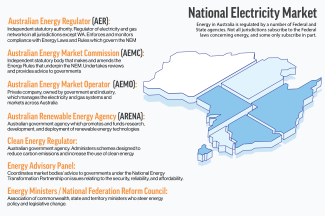
Click on the below drop-down boxes to view an infographic of the stakeholders in each State and Territory.

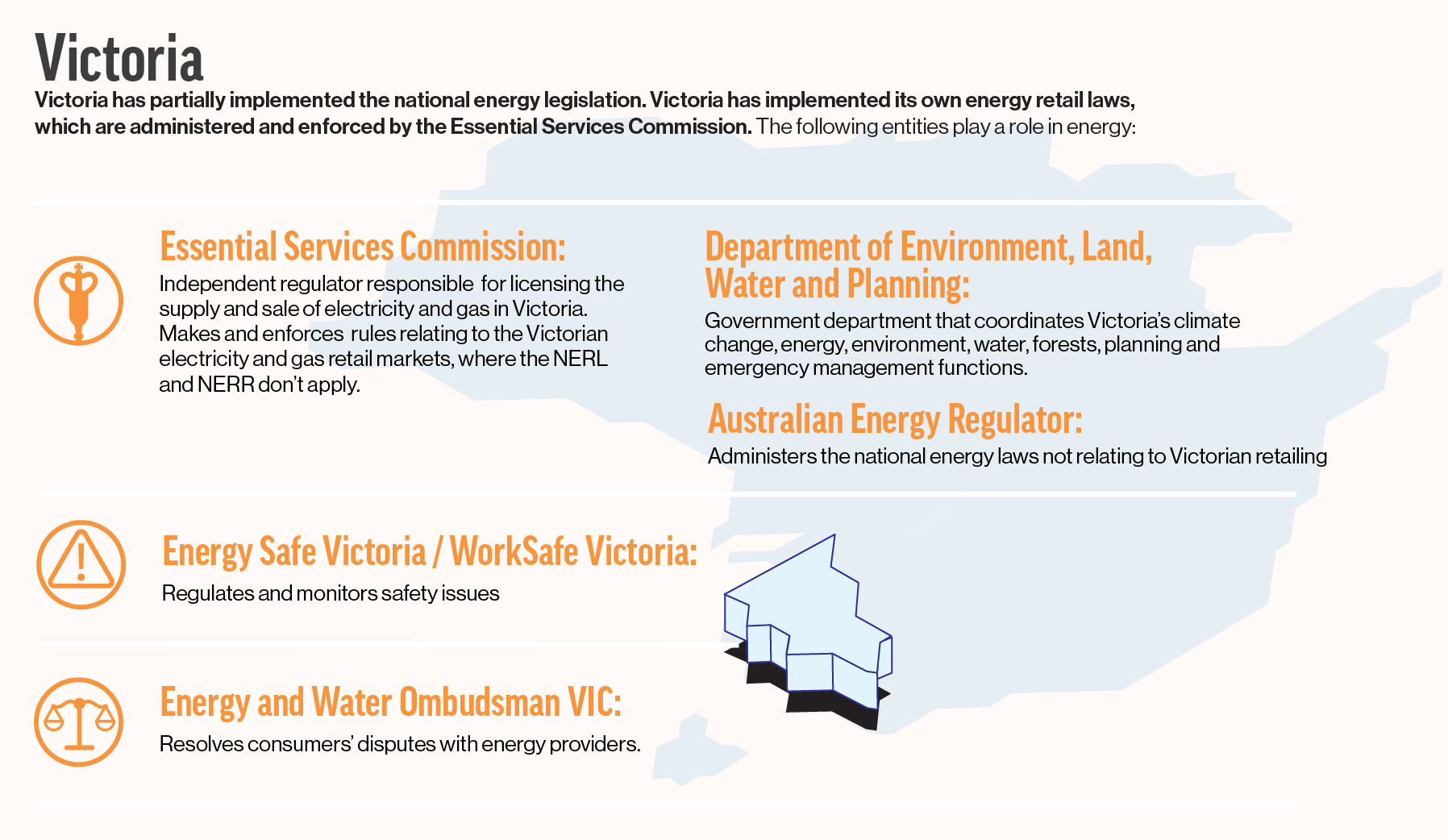
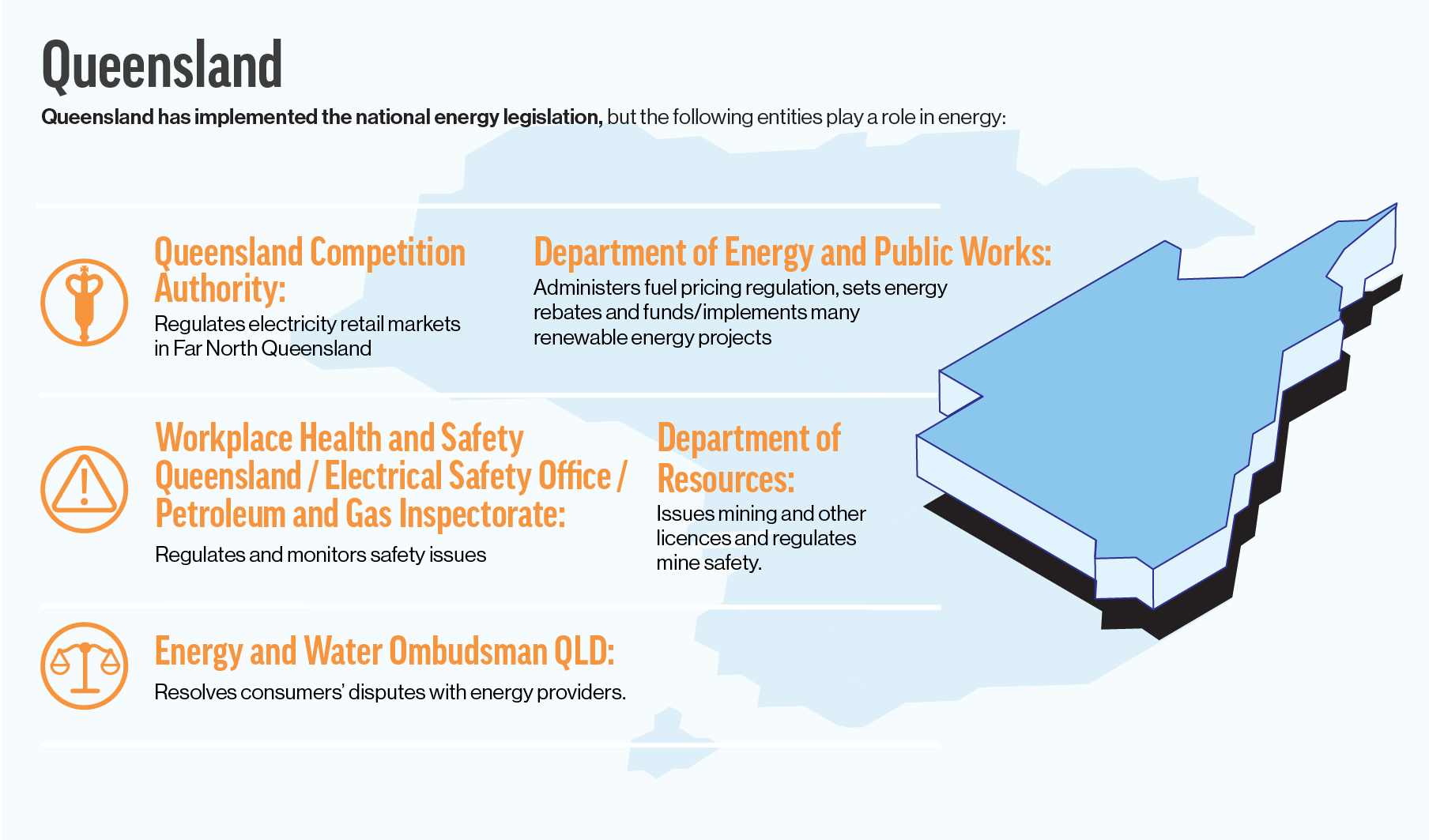
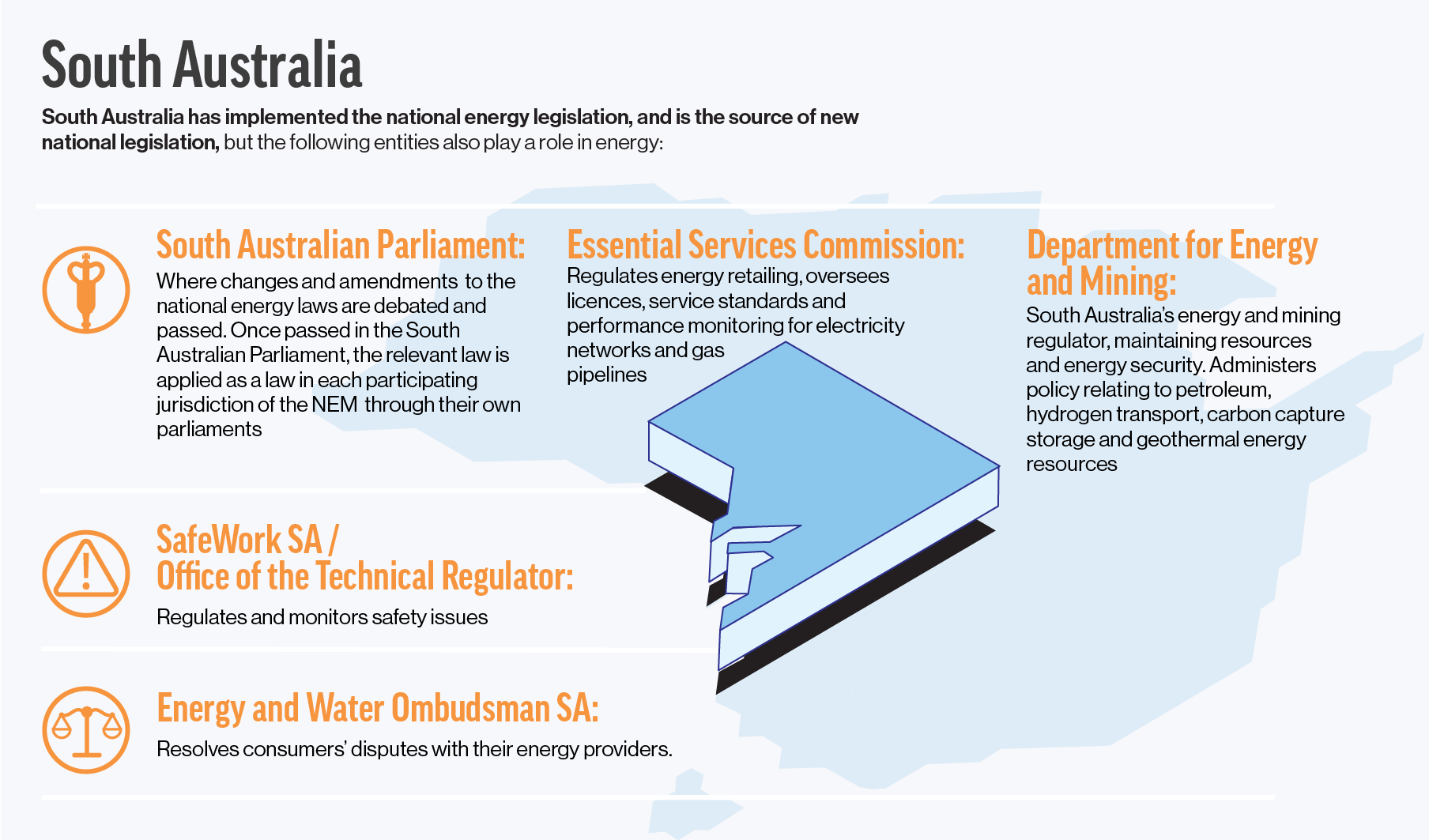
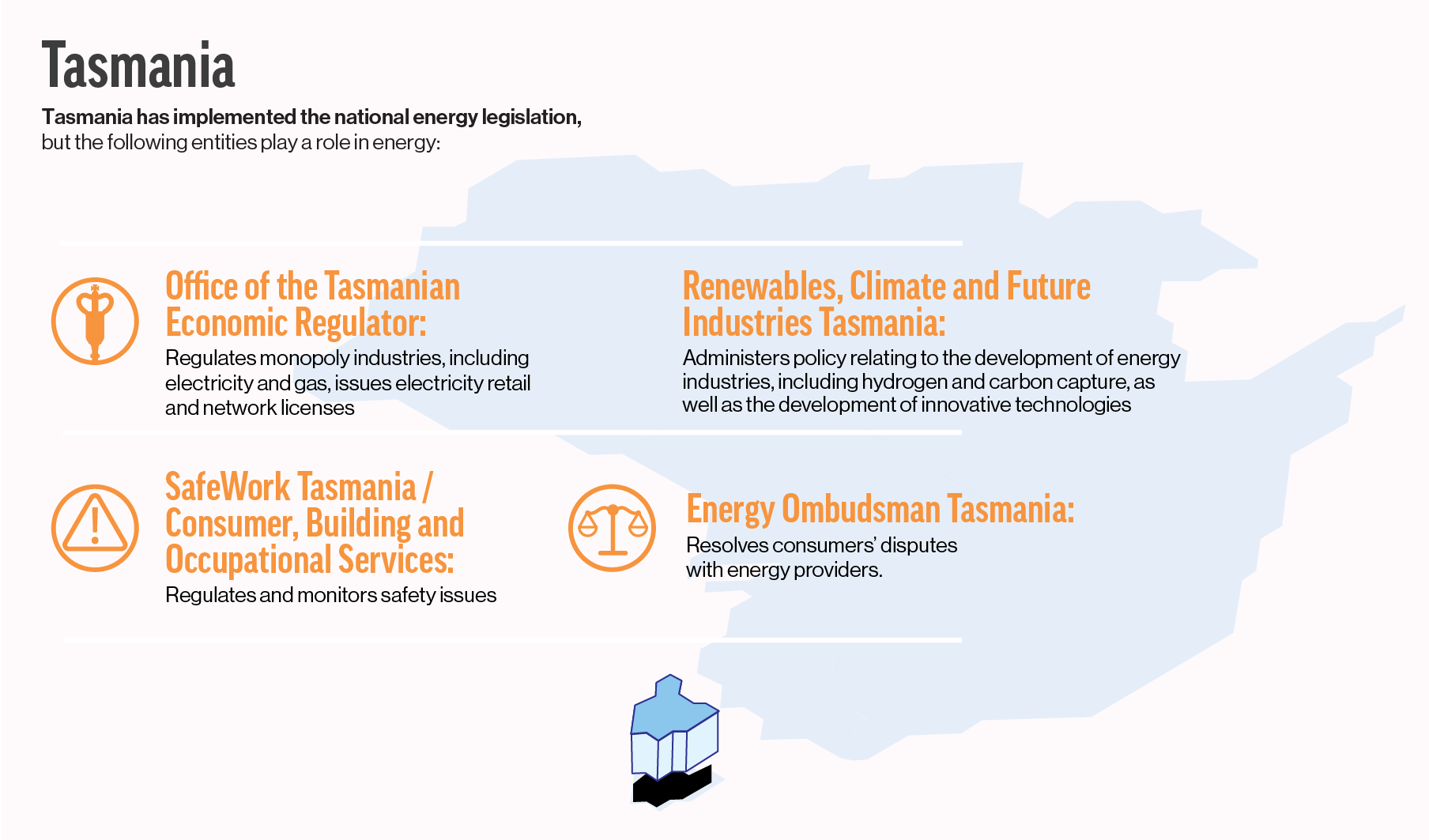
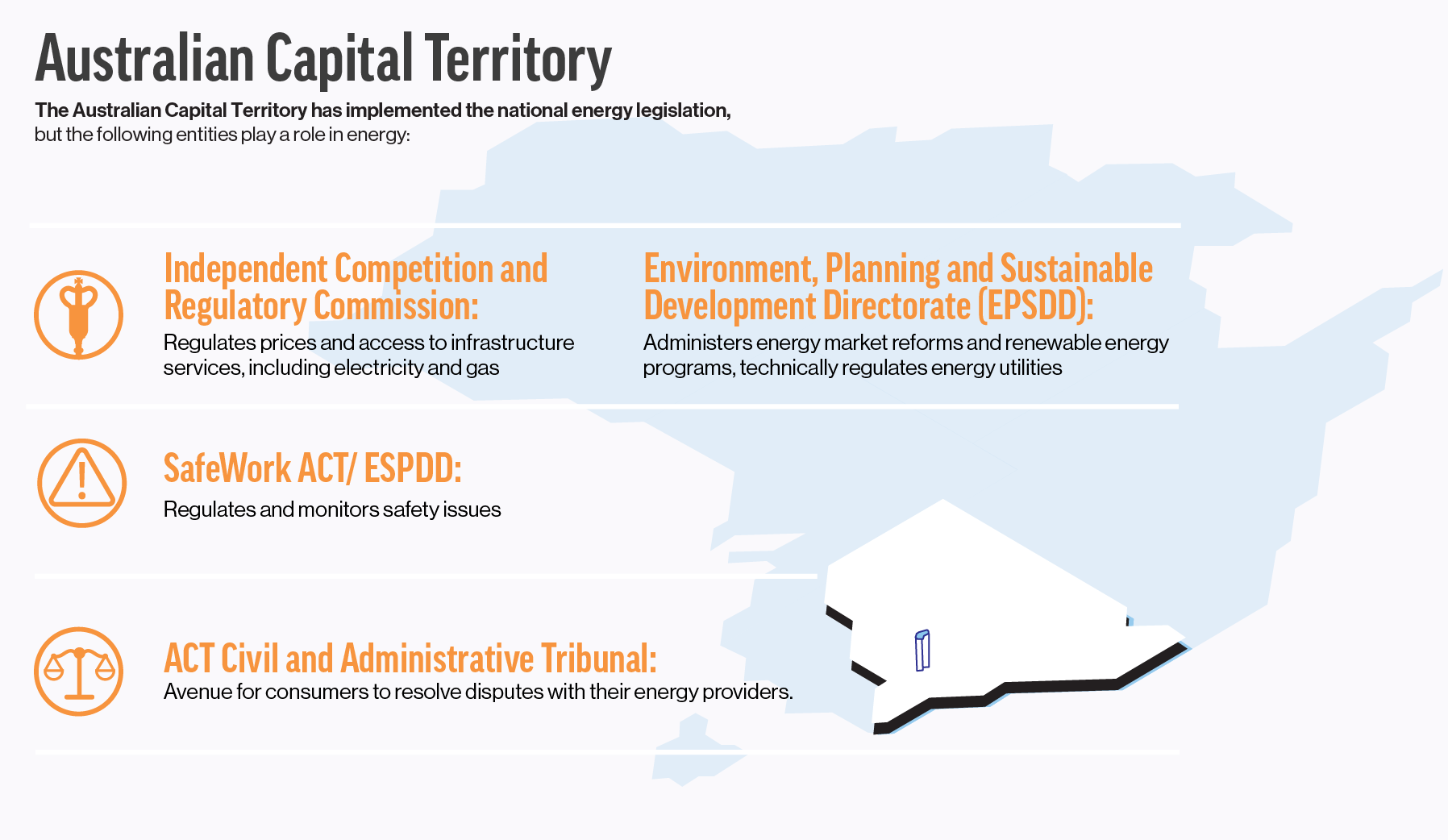
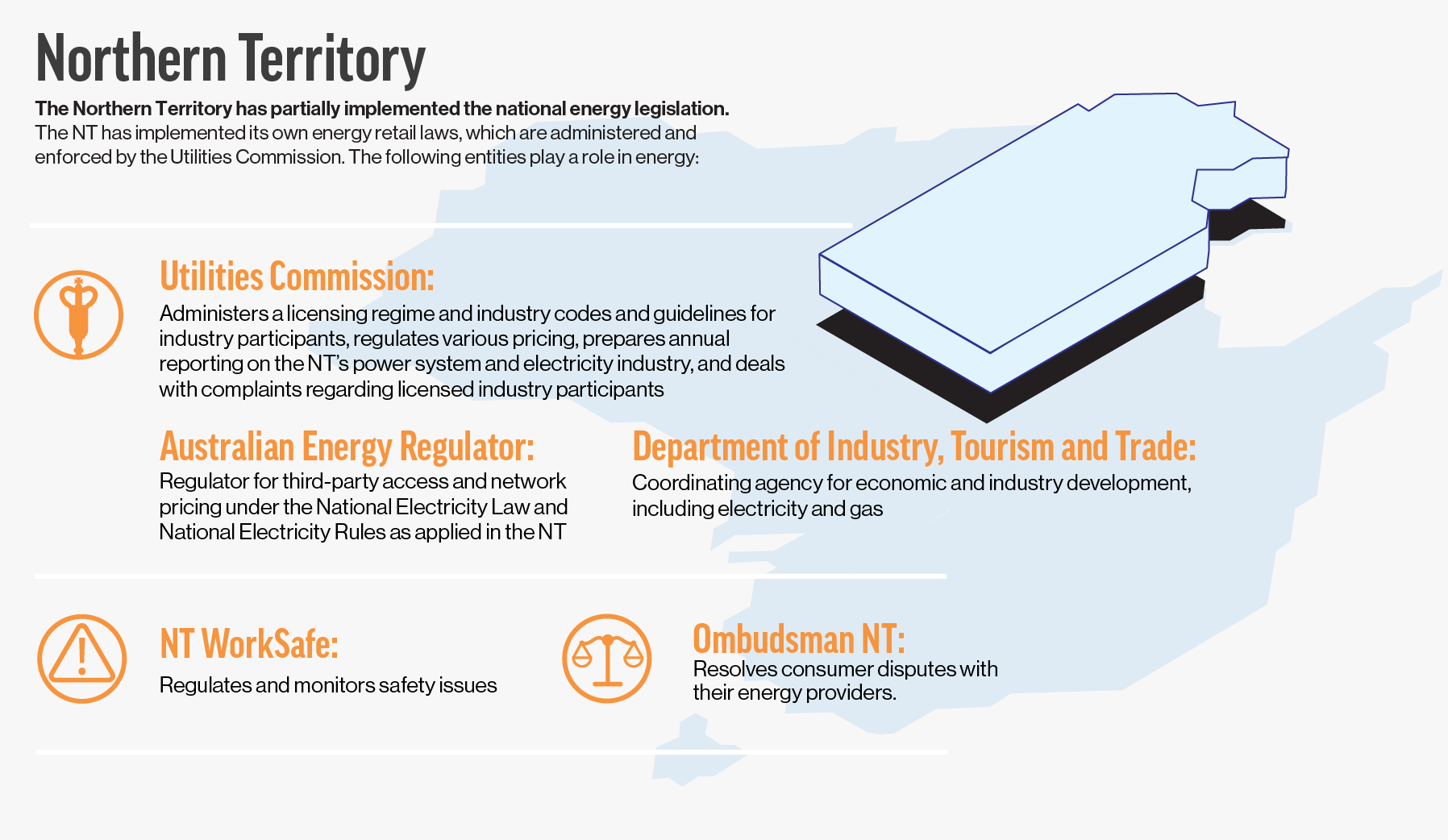
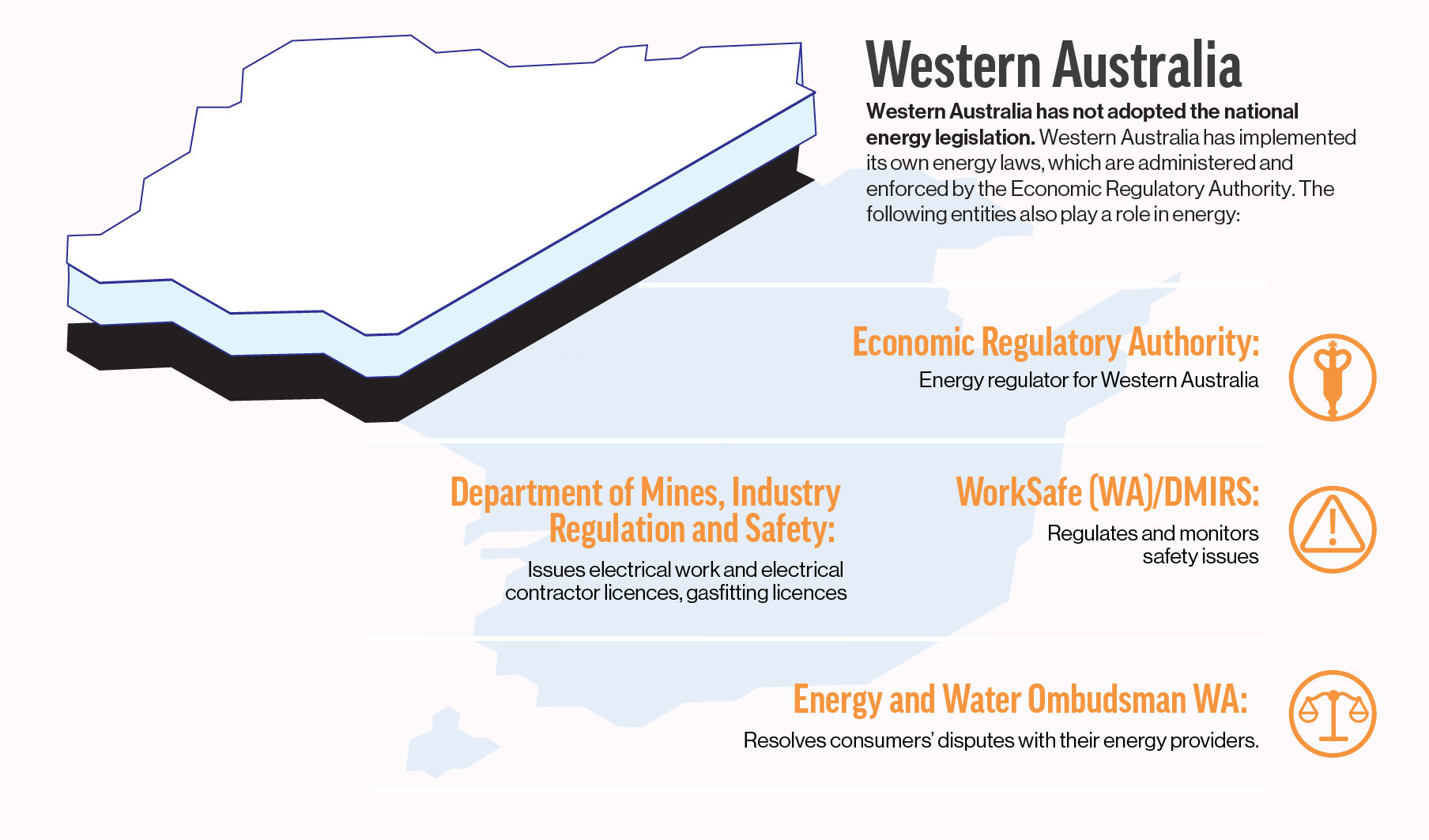
National energy legislation
The operation of the National Electricity Market
Importantly, the NEM does not include Western Australia, which is governed by its own separate legislation. Energy in Western Australia is regulated by the Economic Regulatory Authority, which is outside the scope of the Energy Innovation Toolkit.
Victoria has not adopted the national energy retail customer framework and has a separate set of retail rules. Retail rules in Victoria are regulated by the Essential Services Commission. The Essential Services Commission
There are three overarching national laws which are relevant to the national regulation of energy markets the:
- National Electricity Law
The National Electricity Law (NEL) is contained in a Schedule to the National Electricity (South Australia) Act 1996. It establishes the governance framework and key obligations for the operation of National Electricity Market (NEM), including the regulation of access to electricity networks. It is supported by the National Electricity (South Australia) Regulations. The NEL is applied as law in New South Wales, Queensland, Victoria, South Australia, Tasmania and the Australia Capital Territory by application statutes. The Northern Territory has also applied the NEL with variations that cater to local requirements.(NEL)
- National Gas Law
The National Gas Law (NGL) and the National Gas Rules (NGR) set out the regulation of access to natural gas pipeline services provided by transmission and distribution pipelines under the national energy market framework.(NGL), and the
- National Energy Retail Law
The National Energy Retail Law (NERL), a Schedule to the National Energy Retail Law (South Australia) Act 2011, regulates the supply and sale of energy to retail customers. The Law is supported by the National Energy Retail Rules (NERR) and National Energy Retail Regulations.(NERL).
| Electricity | Gas | Retail |
|---|---|---|
| National Electricity Law (NEL) | National Gas Law (NGL) | National Energy Retail Law (NERL) |
| National Electricity (South Australia) Regulations | National Gas (South Australia) Regulations | National Energy Retail Regulations |
| National Electricity Rules
The National Electricity Rules (NER) are made under the National Electricity Law (NEL) and govern the operation of the National Electricity Market (NEM). The NER determine how companies can operate and participate in the competitive generation and retail sectors, and also govern the economic regulation of electricity transmission and distribution networks. Among other functions, they provide the regulatory framework and processes for market operations, power system security, network connections and access, pricing for network services in the NEM and national transmission planning. In Victoria, however, the national rules for network connections are modified, with many of the network service provider roles being assigned to the Australian Energy Market Operator (AEMO).
(NER) |
National Gas Rules
The National Gas Law (NGL) and the National Gas Rules (NGR) set out the regulation of access to natural gas pipeline services provided by transmission and distribution pipelines under the national energy market framework.
(NGR) |
National Energy Retail Rules
The National Energy Retail Rules (NERR) govern the sale and supply of energy (electricity and natural gas) from retailers and distributors to customers in New South Wales, Queensland, South Australia, Tasmania and the Australian Capital Territory. The NERR have the force of law, and are made by the Australian Energy Market Commission under the National Energy Retail Law (NERL).
(NERR) |
Where South Australia is noted, this is because the States and Territories have agreed to implement South Australian legislation in their own jurisdictions to give effect to the national energy legislation.
Each of these laws has associated rules and guidelines as subordinate legislation which apply to a variety of market participants. More information about the legislation that applies can be found here.
State and territory energy legislation
Victoria is governed by energy retail laws separate to those laws governing the rest of the national energy markets. The Essential Services Commission (ESC) is the regulator of energy retail laws in Victoria and is authorised under its own legislation to implement the Victorian component of the Energy Innovation Toolkit. You can read more about this here.
The ESC is established under the Essential Services Commission Act 2001, and it also has responsibilities under several pieces of Victorian energy legislation, including the Electricity Industry Act 2000 and the Gas Industry Act 2001.
In addition to Victorian specific legislation, other state and territory regulators manage a range of jurisdictional energy frameworks.
- Our Regulation Navigator is an interactive tool which can help identify which state licensing requirements could potentially apply to your business model.
- Our Innovation Enquiry Service provides informal feedback to help you understand what energy regulations might apply to your innovative idea, and can explain which state and territory regulators you will need to contact, and why.
